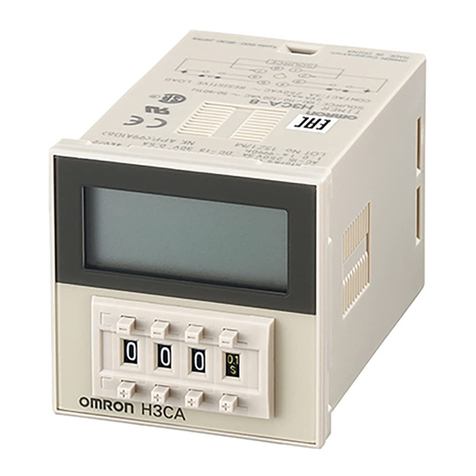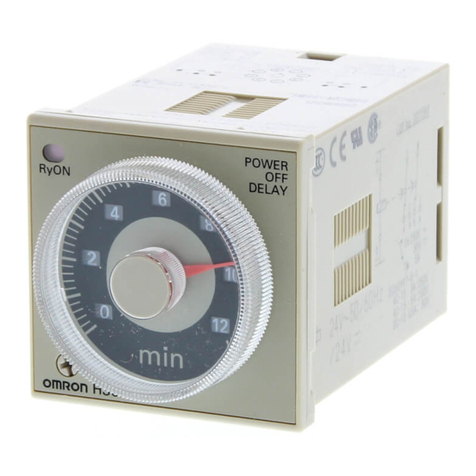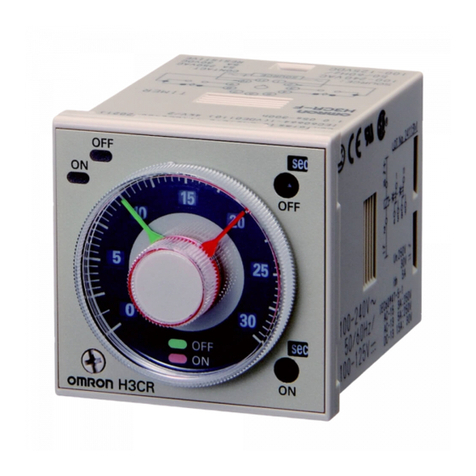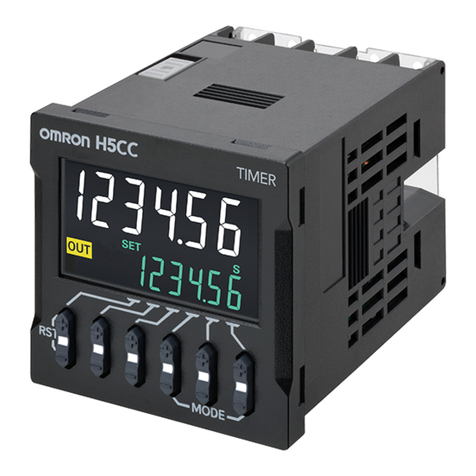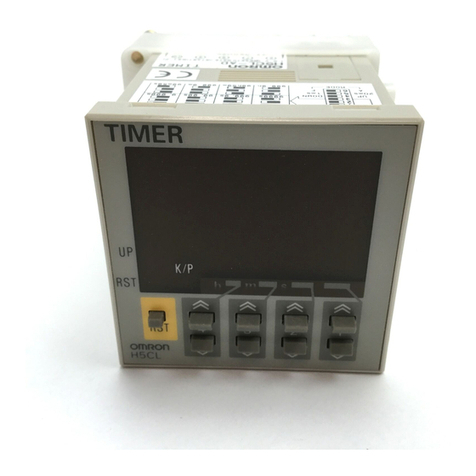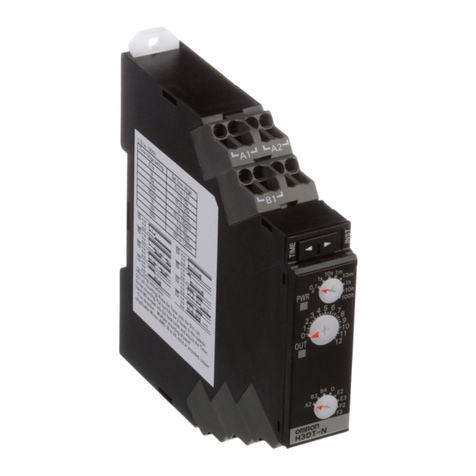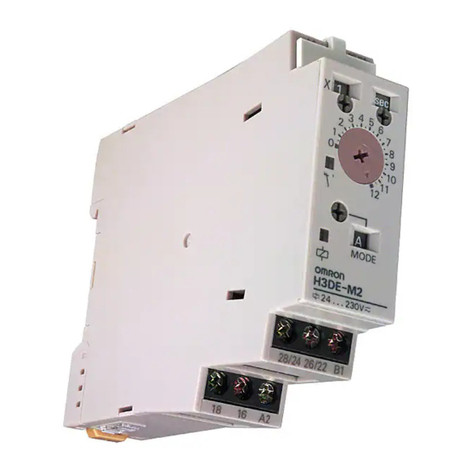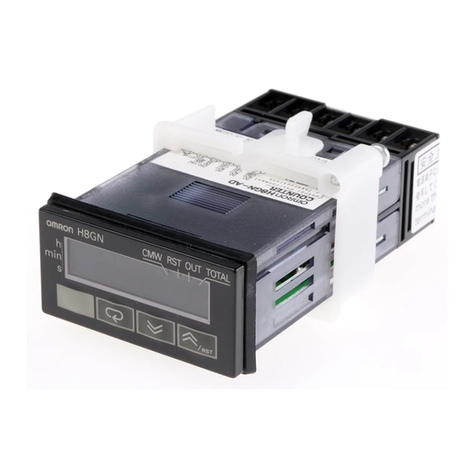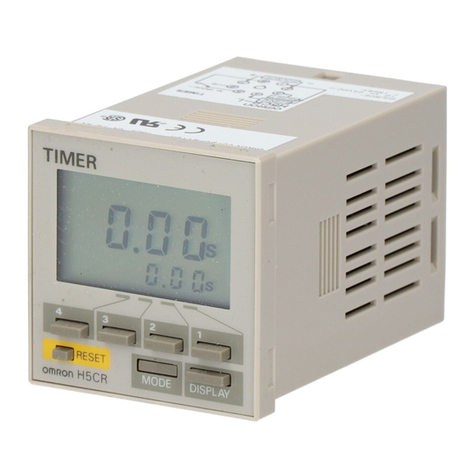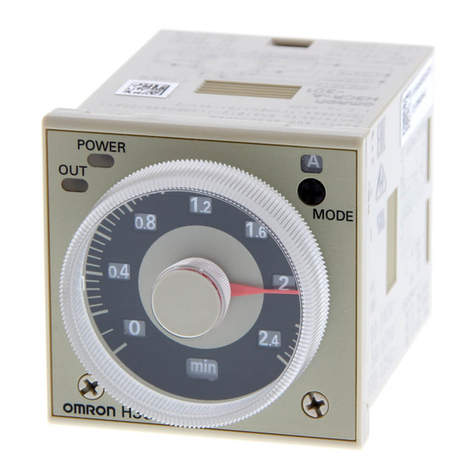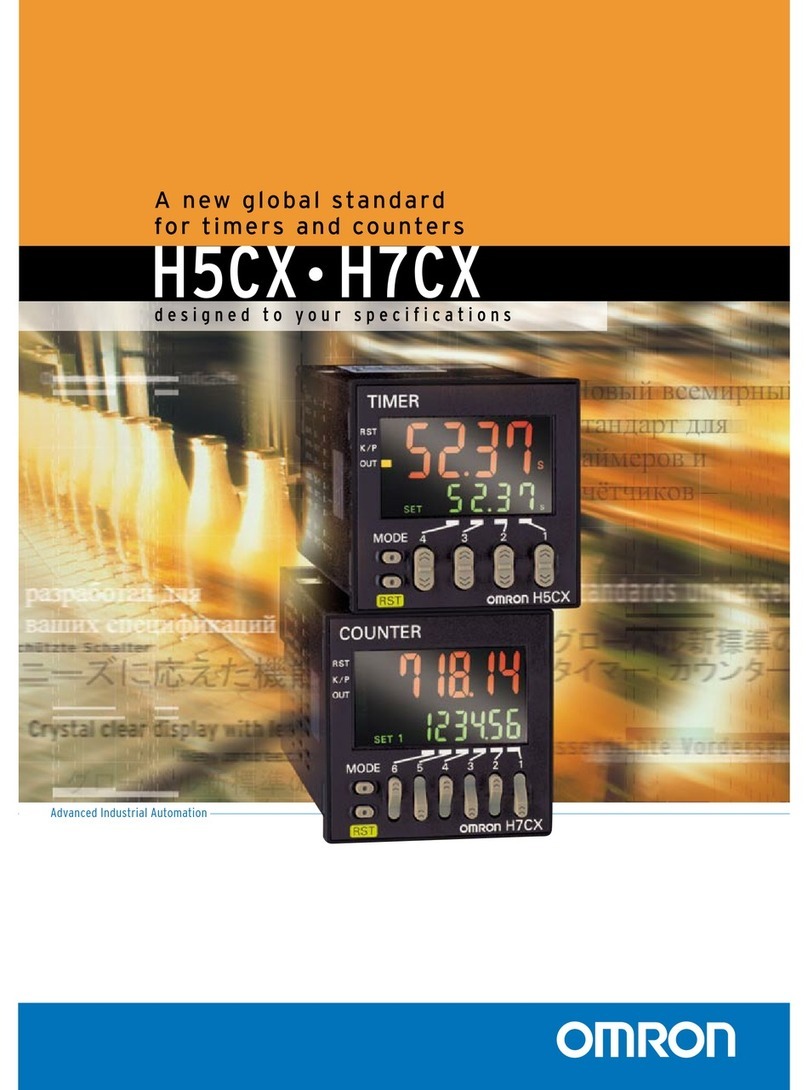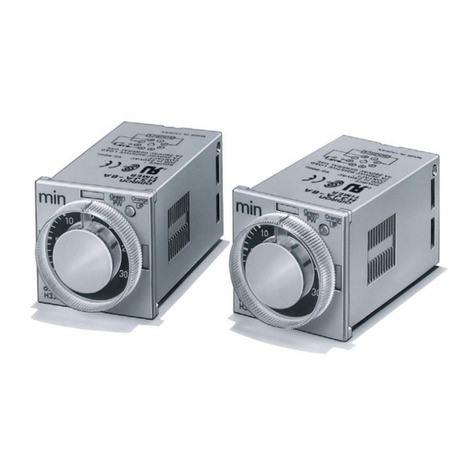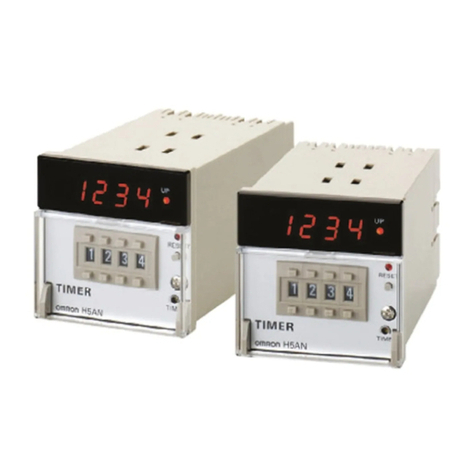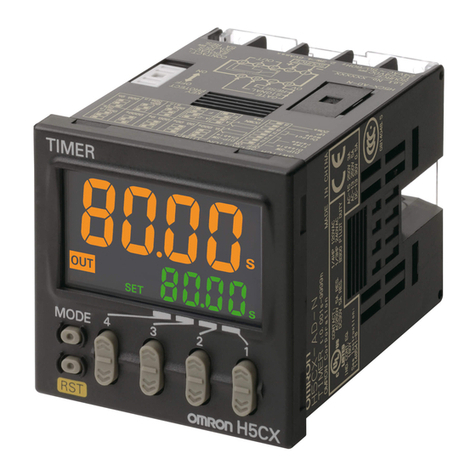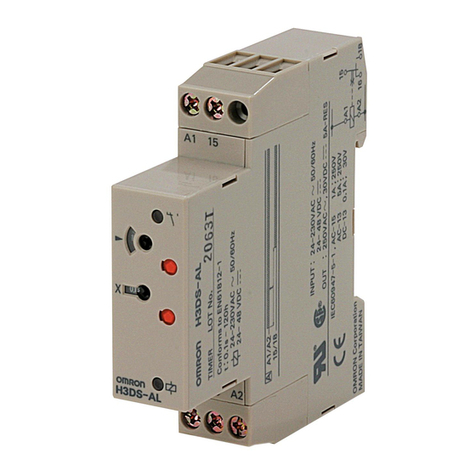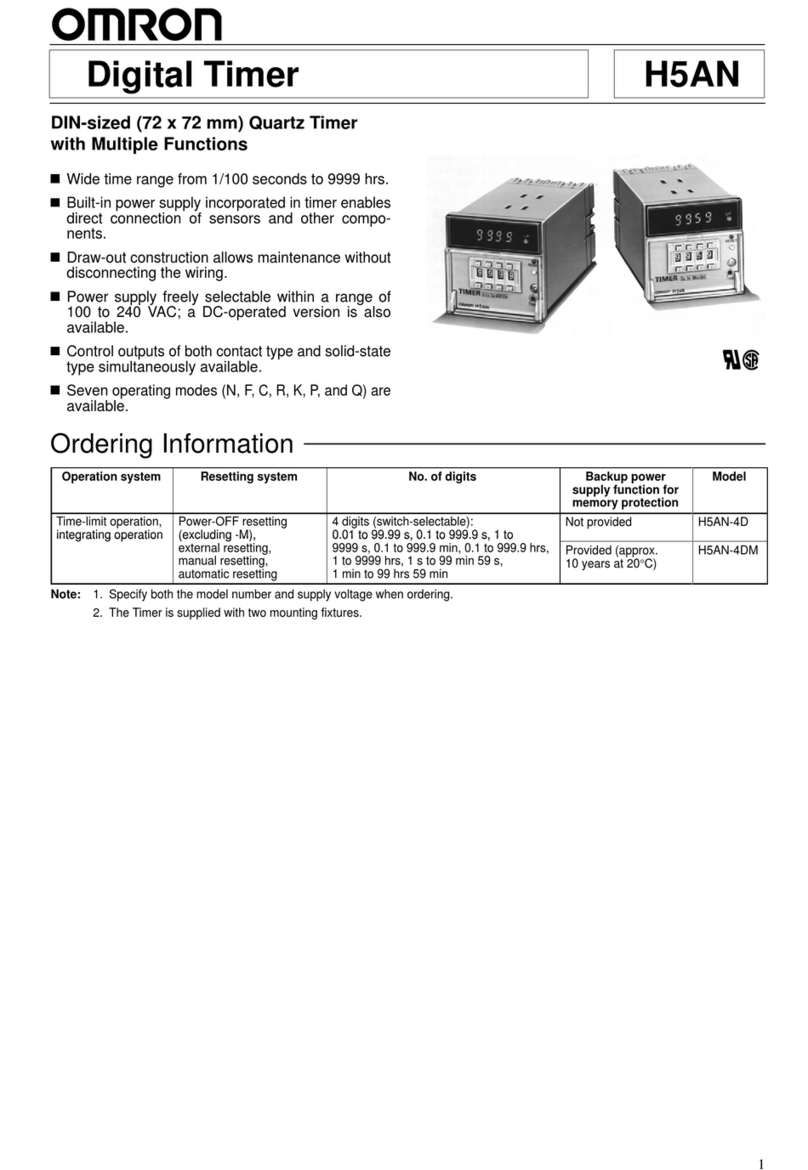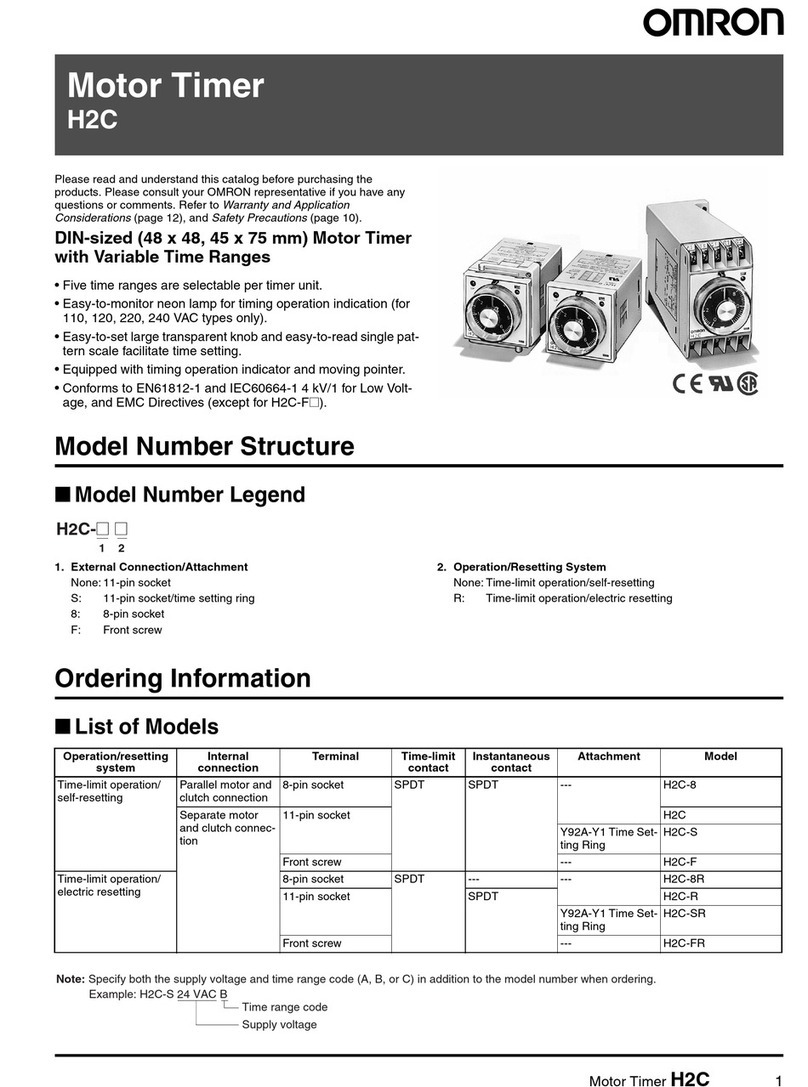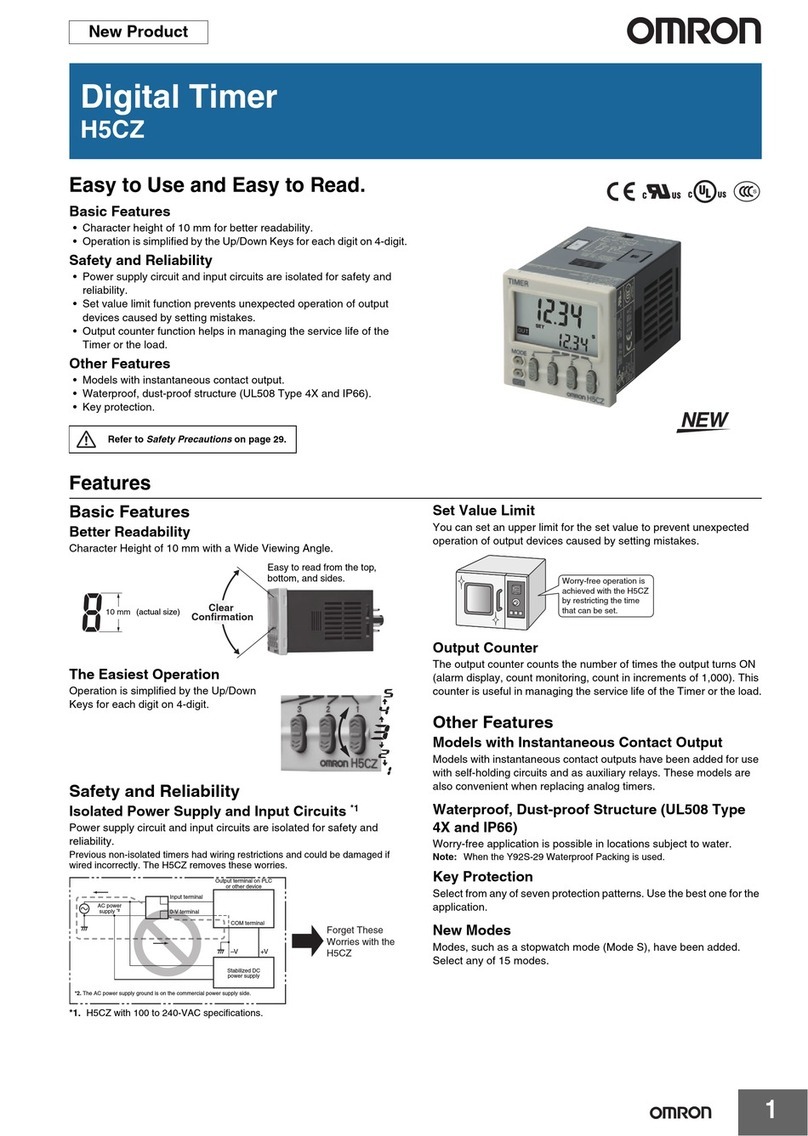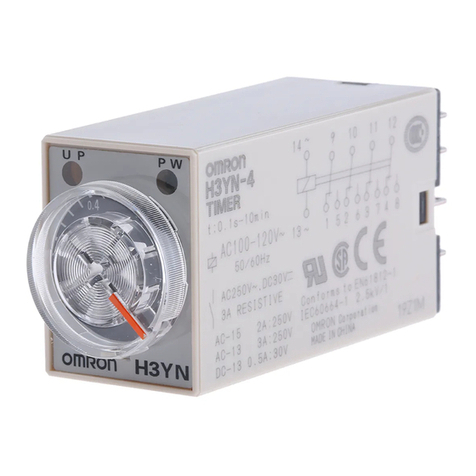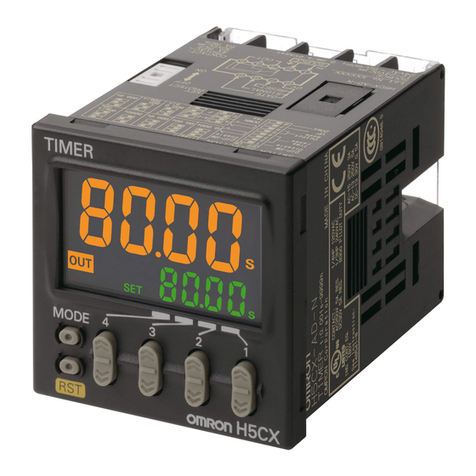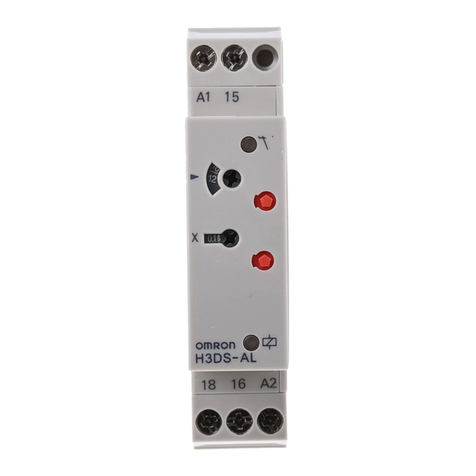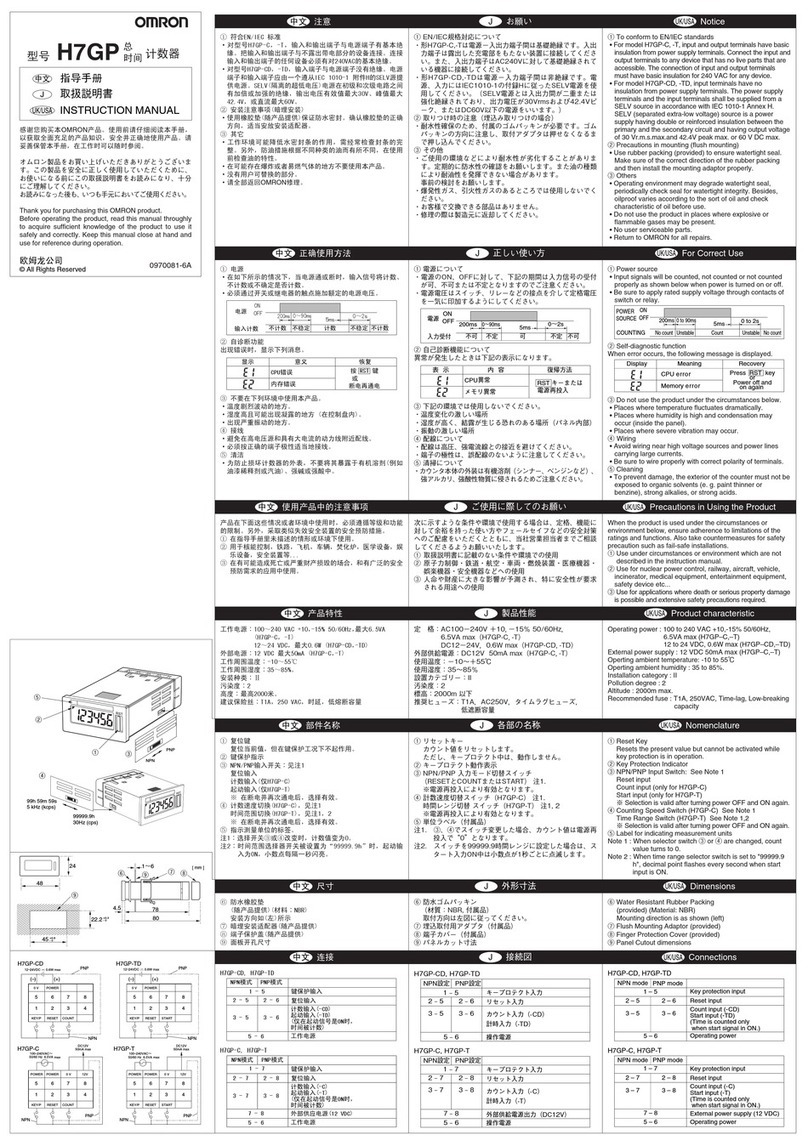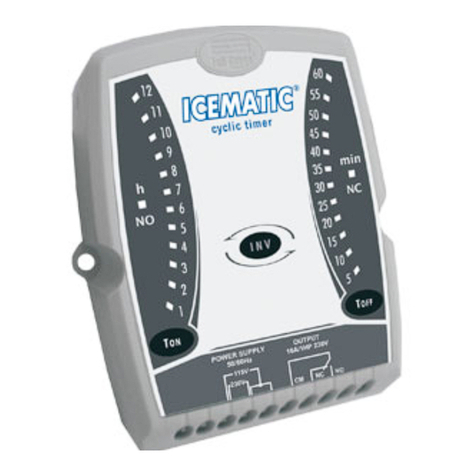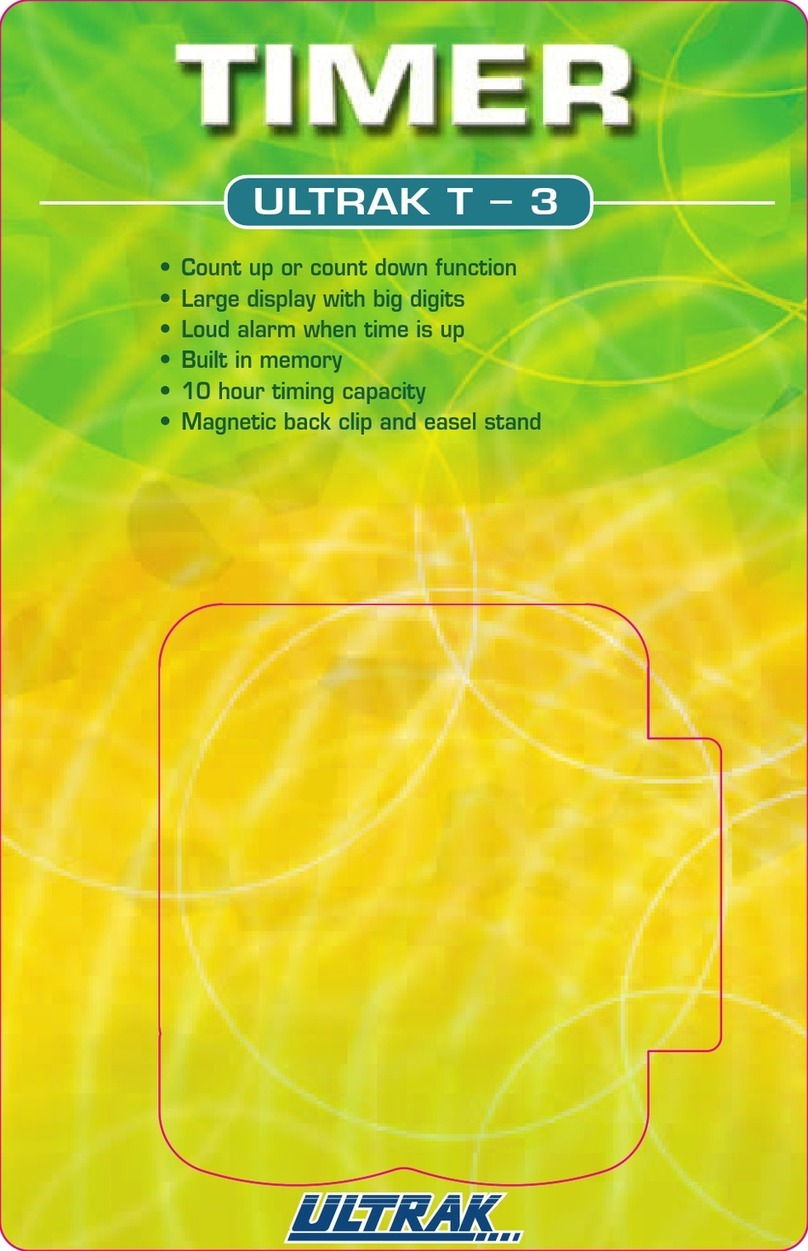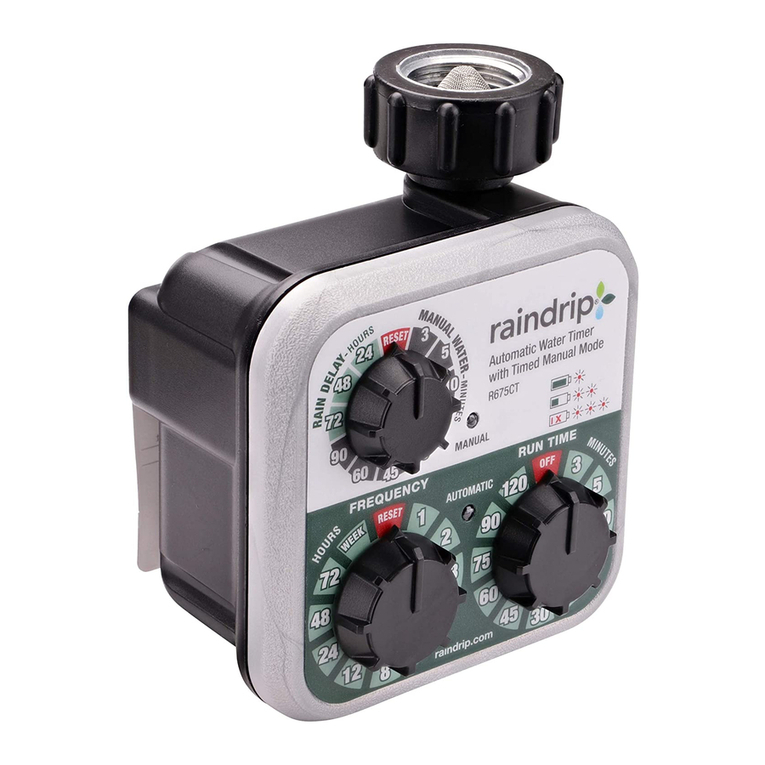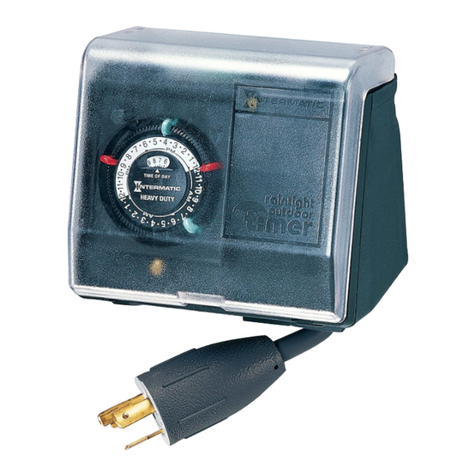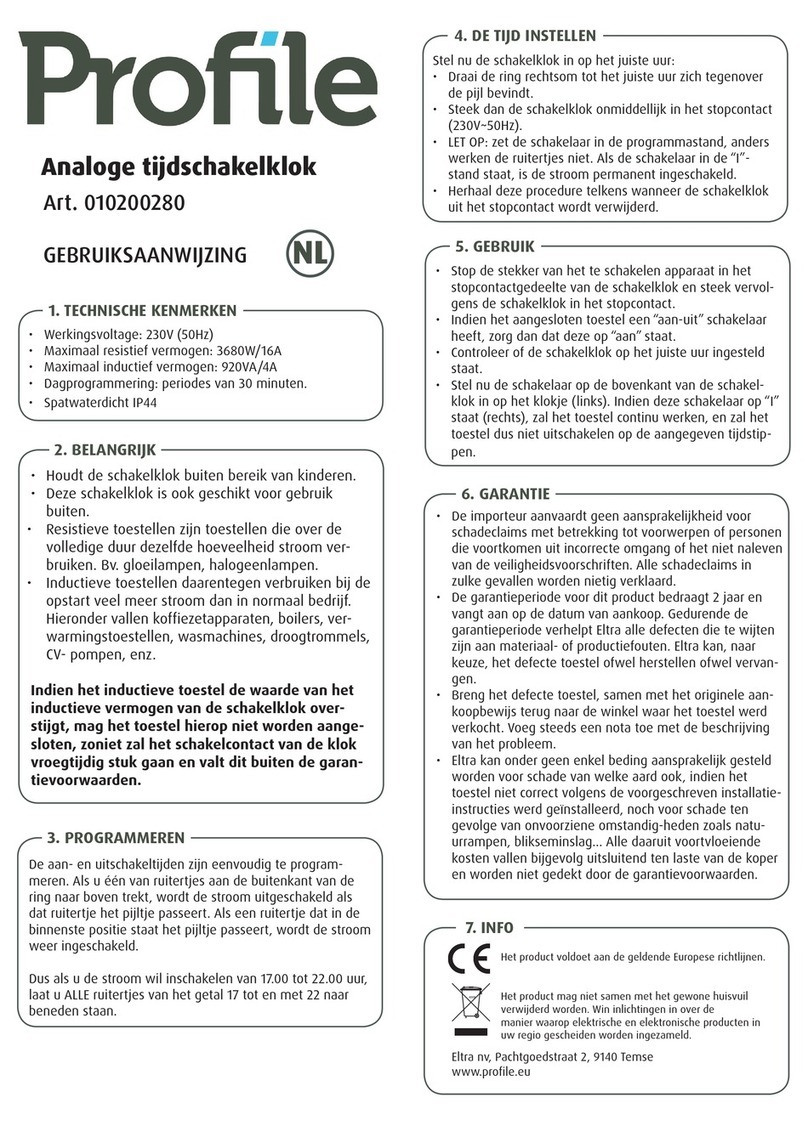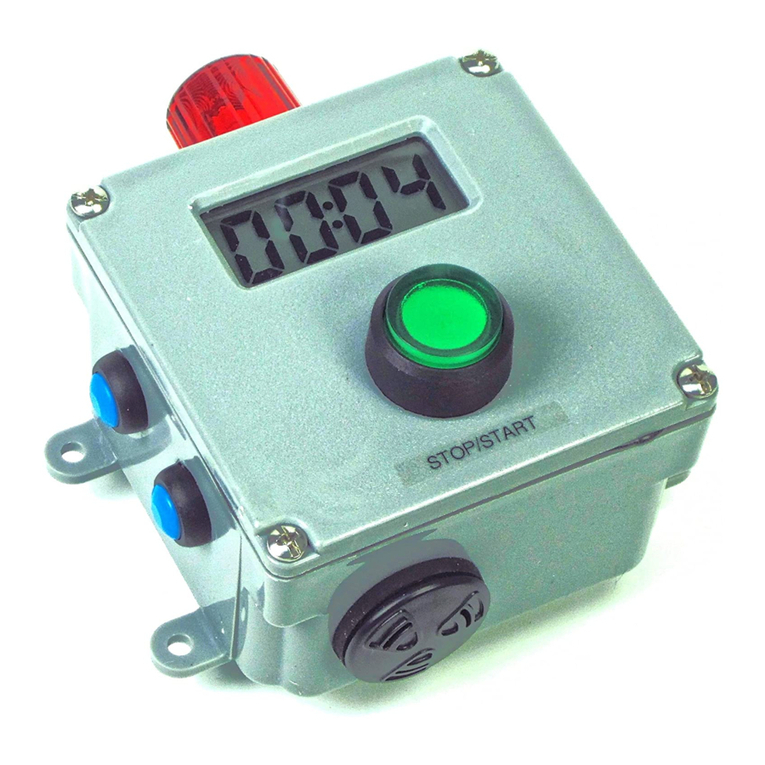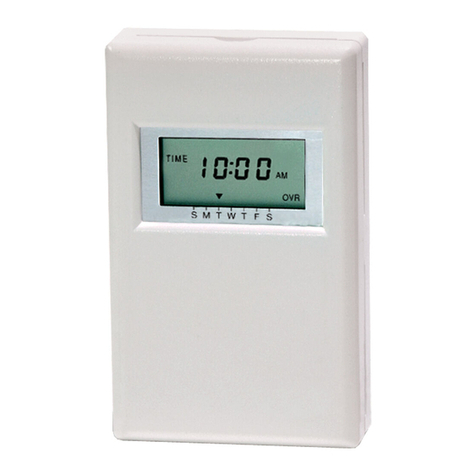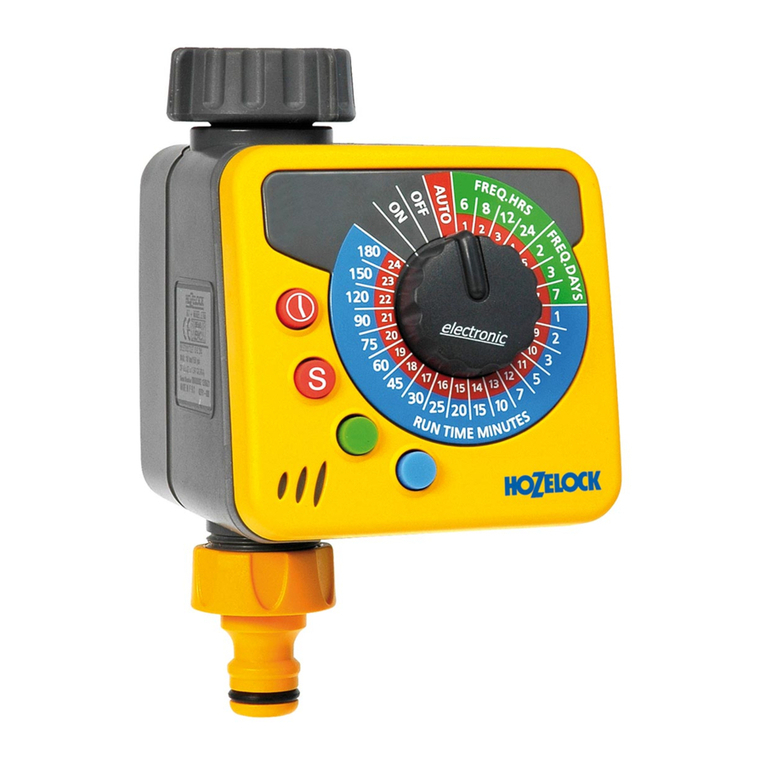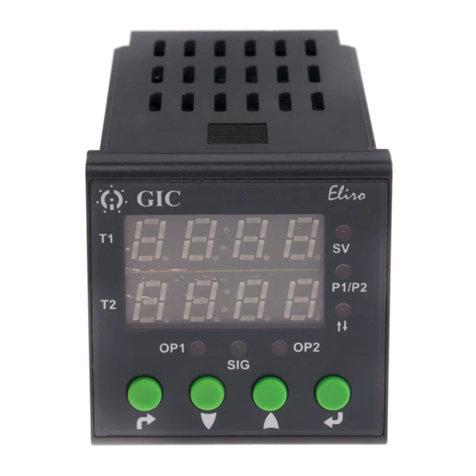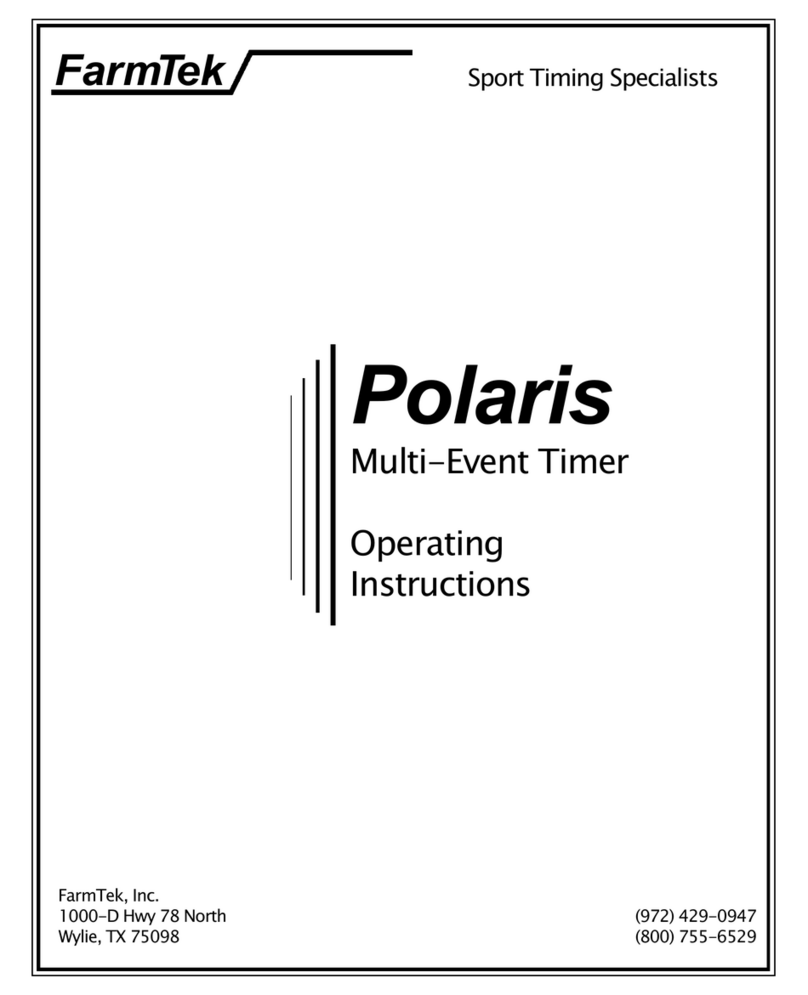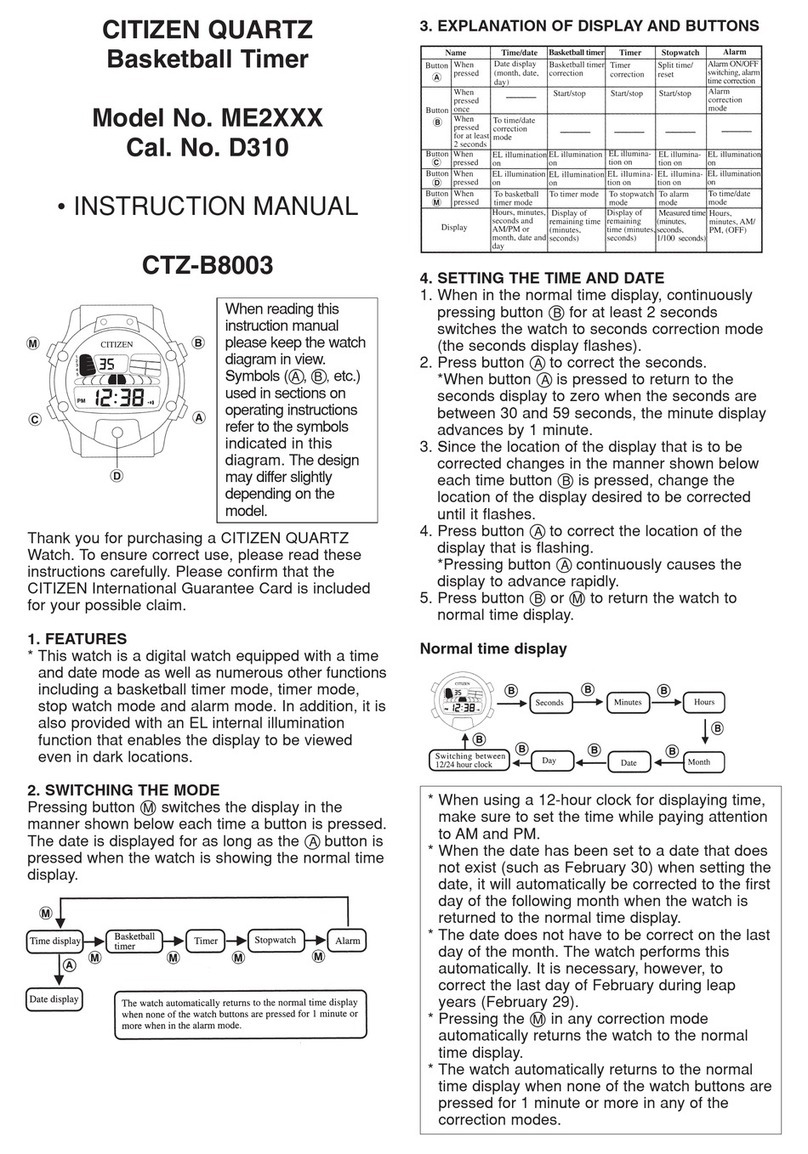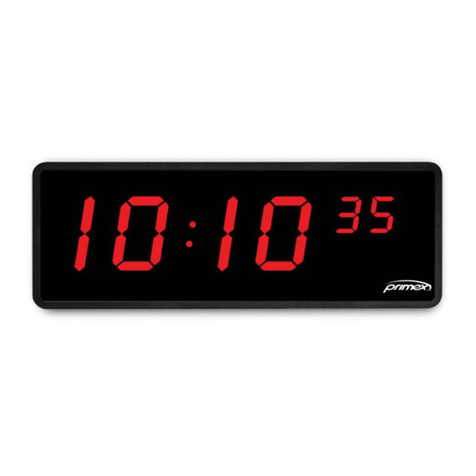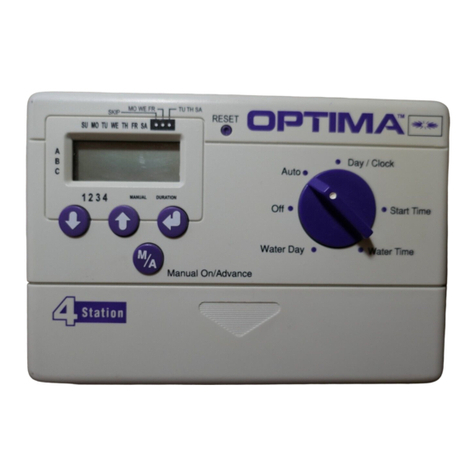S :Entrée de départ
Court-circuiter les bornes !0 et y/wet upour la fonction
démarrage sous tension/ remise à zéro à la coupure.
COM : Connexion commun pour entrée
⑦Tension d'alimentation
⑧Connexion du signal d'entrée (contact)
⑨Connexion des signaux d'entrée statique (PNP)
⑩Connexion des signaux d'entrée statique (NPN)
Remarques : 1. Le signal minimum d'entrée doit être supérieur à 0,05 s.
2. Les conditions que doivent respecter les signaux d'entrés
sont les suivantes
Tension entre les connexions yet u
Entrée ON : 85 à 110% de la tension nominale
(90 à 110% pour les tensions de 24 à 48 Vc.a./
12 à 48 Vc.c. pour les modeles à courant continu.)
Entrée OFF : 10% max. de la tension nominale
S : Starteingang (Sockelklemme 6)
Kurzschlußklemmen !0 und y/ wund ubei Netz-EIN Start- / Netz-
AUS Rücksetzfunktion.
COM : Gemeinsame Anschlußklemme für den Eingang
⑦
Arbeitsspannung
⑧
Kontakt Eingangs Verbindung
⑨
Anschluß von Halbleitersignal-Eingängen (PNP)
⑩
Anschluß von Halbleitersignal-Eingängen (NPN)
Anmerkung :1. Die kürzeste Zeit für den Eingang beträgt 0.05s.
2. Die Bedingung für den Eingang ist folgendermaßen.
Spannung zwischen den Schraubenklemmen yund u
Eingang EIN : 85 bis 110 % der Nennspannung
( 90 bis 110 % bei dem 24 bis 48 VAC/12 bis 48
VDC Gerät bei DC Last )
Eingang AUS : maximal 10 % der Nennspannung
S : Start input (Always connect)
Short-circuit terminals !0 and y/w and ufor Power-ON start /
Power-OFF reset operation.
COM : Common terminal for input
⑦Operating power
⑧Contact input signal connection
⑨Solid-state input signal connection (PNP)
⑩Solid-state input signal connection (NPN)
Note: 1.Min. signal input time is 0.05 s.
2.Input condition is as follows.
Voltage between terminals yand u
Input ON : 85 to 110 % of the rated supply voltage
(90 to 110 % for 24 to 48 VAC/12 to 48 VDC model at
DC load)
Input OFF : 10 % max. of the rated supply voltage
Model
H3CR-AP
SOLID-STATETIMER
INSTRUCTION SHEET
Bedienungsanleitung
Manuel d'instructions
OMRON Corporation 11P
Bitte lesen Sie diese Betriebsanleitung
sorgfältig durch, bevor Sie mit dem Gerät
arbeiten.
Thank you for purchasing this OMRON
product. This manual primarily describes
precautions required in installing and wiring
the timer. Before operating the product ,read
this manual thoroughly to acquire sufficient
knowledge of the product. Keep this manual
for future reference.
Avant d'utiliser ce produit, veuillez, s'il
vous plait, lire attentivement ce manuel
pour vous familiariser avec le produit.
Karasuma Nanajo, Shimogyo-ku,
Kyoto 600, Japan
UK/USA
D
F
POWER
OUT
MODE
H3CR
0
5
10
15
20
25
30
min
➁
➂
➃
➄
➅
(A, B, B2, C, D, E)
(sec, min, hrs, 10h)
(1.2, 3, 12, 30)
➀
48
48 φ39
66.6
44.8
□
15
652.30.7
45
+
0.6
0
45
R0.5max.
t=1〜5
+
0.6
0
A
[mm]
!0―y
*2(power)
t
o―!1
tttttttt
*3
*1(out)
(START)
●H3CR-AP
〜
(−)
(〜) (+)
(〜)
{
➆
SCOM
➇
➉
− +
− +
➈
− +
DC
DC
H3CR-AP
H3CR-AP
〜
10
10
2
2
7
6
7
6
*1
10
2
6
7
H3CR-AP
〜
⑪
⑫
+
−
Power supply
circuit
Input circuit
Contact for
external Input signal
H3CR-AP
H3CR-AP
〜
10
10
2
2
7
6
7
6
Contact for
external Input signal
―
*2(power)
t
―
*3 *3 *3
*1(out)
t t-a t
(START)
―
*2(power)
―
*1(out)
t
*3
(START)
―
*2(power)
t
―
*3
*1(out)
t
*3
(START)
Nomenclature
UK/USA
Bezeichnungen der Teile
Nomenclature
①Power indicator
②Output indicator
③Rated time selector
④Time unit selector
⑤Setting dial (setting time value)
⑥Operation mode selector
Note:If pointer is turned counterclockwise
until overranged, instantaneous output
will be issued. (zero point instantaneous
operation)
Dimensions
A−Panel cutout dimensions
Applicable socket
Model P2CF-11
Front connection socket
Model P3GA-11
Back connection socket
Timing charts
Connections
Mode
A.
Signal ON de-
lay operation
*1:Output indicator
*2:(power)indicator
*3:flicker
Mode B.
Signal ON
flicker, OFF
start operation
*1:Output indicator
*2:(power)indicator
*3:flicker
Mode B2.
Signal ON
flicker, ON
start operation
*1:Output indicator
*2:(power)indicator
*3:flicker
Mode
C.
Signal ON•OFF
delay operation
*1:Output indicator
*2:(power)indicator
*3:flicker
Mode
D.
Signal OFF
delay
operation
*1:Output indicator
*2:(power)indicator
*3:flicker
Mode
E.
Signal ON
interval
operation
*1:Output indicator
*2:(power)indicator
*3:flicker
⑬
①
Spannungsversorgungsanzeige
②
Ausgangsanzeige
③
Zeitbereichsschalter
④
Zeiteinheitwahlschalter
⑤
Einstellscheibe (eigestellte Zeitdauer)
⑥
Betriebsartwahlschalter
Hinweis: Sofortausgang(Sofortbetrieb)
kann durch Drehung der Einstellscheibe
auf 0 eigestellt werden.
①Voyant d'alimentation en courant
②Voyant de puissance de sortrie
③Sélecteur de temps nominal
④Sélecteur de temps
⑤Cadran de réglage (réglage du temps)
⑥Sélecteur du mode de fonctionnement
Remarque :Use sortie instantanée est pos-
sible en plaçant le cadran sur le réglage 0
(mode sortie instantanée).
Abmessungen
Dimensions
A−
Frontplattenausschnitt
Verwendbare Sockel
P2CF-11
Frontseitige Klemmen
P3GA-11
Rückseitige Klemmen
A−Découpe du panneau
Socle
Modèle P2CF-11
Socle à connexion avant
Modèle P3GA-11
Socle à connexion arrière
Zeitablauf
Tableaux de minutage
Anschlußanordnung
Brochage
Bitte folgen Sie genau den folgenden Hinweisen.
Die gewährleisten eine sichere Funktion des Zeitrelais.
(1) Setzen Sie das Zeitrelais nicht unter den folgenden
Bedingungen ein :
• Erhebliche Temperaturschwankungen
• Hohe Luftfeuchtigkeit oder wenn Kondensation entstehen könnte
• Vermeiden Sie starke Vibration oder Schock
• Korrosieves Gas oder staubige Umgebung
• Bei plätscherndem Wasser, Öl oder irgendwelche Chemikalien
• Wenn in der Umgebung explosive oder entflammbare Gase sind
(2) Spannungsversorgung
Stellen Sie sicher, daß die Spannungsversorgung innerhalb des angegebenen
Bereiches liegt.
(3) Handhabung
Demontieren, modifizieren und reparieren Sie bitte niemals das Gerät.
(4)
Stellen Sie sicher, daß das Produkt den Anforderungen Ihrer
Anwendung entspricht.
(5)
Schließen Sie die Drähte mit der richtigen Polarität an.
(6)
Montieren Sie das Zeitrelais und die Eingangsverdrahtungen soweit wie möglich
von elektrischen Störungen oder Starkstromschaltgeräten entfernt.
(7)
Verwenden Sie das Zeitrelais nur innerhalb des Temperaturbereiches von -10 bis
+55 °C und bei einer relativen Luftfeuchtigkeit zwischen 35 und 85%.
(8) Reinigung
Verwenden Sie keine Verdünnung für Lacke o.ä., sondern nur
Reinigungsalkohole.
(9)
Ändern Sie niemals die Zeiteinheit, den Zeitbereich oder den Arbeitsmodus
während das Gerät arbeitet, andernfalls wird eine Fehlfunktion daraus
resultieren. Stellen Sie sicher, daß bei derartigen Änderungen die Netzspannung
abgeschaltet ist.
(10) Beziehung zwischen Eingang und Schaltkreis der Spannungsversorgung
⑪Da der Eingangsschaltkreis und der Schaltkreis der Spannungsversorgung
unabhãngig voneinander sind, kann der Eingangsschaltkreis ungeachtet vom
EIN/AUS Zustand der Spannungsversorgung EIN oder AUS geschaltet werden.
Beachten Sie, daß eine gleichwertige Spannung zur Netzspannungsversorgung
am Eingangsschaltkreis anliegt.
⑫Wenn gleichzeitig Eingangssignale an mehrere Zeitrelais gehen, die von
demselben Eingangskontakt kommen, muß die Phasenlage der
Spannungsversorgungen übereinstimmen ( *1 ).
Wenn die Phasenlage der Spannungsversorgungen nicht gleich ist, wird ein
Kurzschluß erzeugt.
(11) Verdrahtung der Eingänge
Die Drähte zu den Eingangsklemmen müssen so kurz wie möglich sein.
Wenn die Leitungskapazität der Drähte 1.200 pF übersteigt ( ca. 10m Kabellänge
bei 120 pF/m ), wird die Funktion des Gerätes beeinflußt.
Beachten Sie insbesondere die Leitungskapazität bei abgeschirmten Kabeln.
(12) Anschluß der Netzspannung
Verwenden Sie eine Gleichspannungsversorgung mit einer Restwelligkeit von
20% oder weniger und eine mittlere Spannung, die innerhalb des angegebenen
Bereiches für die Betriebsspannung des Zeitrelais liegt.
Stellen Sie sicher, daß die Spannung über die ganze Zeit am Zeitrelais ansteht.
Verwenden Sie Kontakte, wie z.B. ein Relais.
Andernfalls kann das Zeitrelais nicht ordentlich arbeiten.
Es könnte z.B. die Netzrückstellung oder der Endzeitpunkt geschaltet werden,
obwohl die Zeit noch nicht abgelaufen ist.
(13)
Bitte übersteigen Sie niemals den Spannungswert, der auf dem Zeitrelais
vermerkt ist.
Wenn die an den Eingangs- oder Netzspannungsklemmen angelegte Spannung
von der Nennspannung abweicht, können die internen Bauteile beschädigt
werden.
(14)
Wenn die Durchschlagsfestigkeit eines Transistors am Transistoreingang
niedriger als die Nennspannung ist, kann der Transistor beschädigt werden.
(15)
Bitte beachten Sie die nebenstehende Zeichnung.( ⑬)
Verknüpfen Sie das Netz über ein Relais mit dem Zeitrelais, so daß es niemals
über eine längere Zeit (ein Monat oder länger) in der Funktion „Zeit abgelaufen”
stehen bleibt.
Es könnten sonst Bauteile wie z.B. Elektrolytkondensatoren vorzeitig zerstört
werden.
Veuillez suivre précisément les instructions suivantes afin d'utiliser
correctement la minuterie.
(1) Pour une bonne utilisation de la minuterie, veuillez éviter les con-
ditions suivantes:
• Les fortes variations de température
• Les zones à forte humidité où de la condensation pourrait se former
• Les chocs est les vibrations trop importantes.
• Les environnement poussiéreux ou contenant des gaz corrosifs,
• Les endroits où il y a des risques d'éclaboussures d'eau, d'huile ou
autres produits chimiques.
• Les ambiances explosives ou avec des gaz fortement inflammables.
(2) Alimantation
Vérifier que la tension d’alimentation correspond à celle du produit.
(3) Manipulations
Ne jamais désassembler, modifier ou réparer ce produit.
(4) Assurez vous que le produit correspond à votre application.
(5) Connectez les bornes avec la bonne polarité
(6) Placez la minuterie et ses éléments de commande, à distance de toute
source de perturbation et d'alimentation haute tension.
(7) Utilisez la minuterie avec une température ambiante entre -10°et
55°et une humidité relative entre 35 et 85%.
(8) Nettoyage
N'utilisez pas des solvants de peinture ou équivalents. Utilisez des
produits à base d'alcool.
(9) Ne changez pas le temps, la gamme de temps ou la fonction alors que
la minuterie est en fonctionnement. Sinon un dysfonctionnement
pourrait survenir. Soyez sûr d’être en position off.
(10)Relation entre l'entrée et le circuit d'alimentation
⑪Si le circuit de commande et le circuit d'alimentation sont configurés
indépendamment, le circuit d'entrée peut passer de ON à OFF
indépendamment de l'état du circuit d'alimentation.
Remarquez que la tension d'entrée et la tension d'alimentation sont
équivalentes.
⑫En cas de commande simultanée sur plus d'une minuterie provenant
du même contact d'entrée, la phase de l'alimentation doit satisfaire
(*1).
Si les alimentations ne sont pas en phase un court-circuit peut
survenir.
(11) Câblage des entrées
Les câbles des signaux d'entrée doivent être les plus courts possibles.
Si la capacité de ligne du câble excède 1200 pF (par exemple 10 m de
câble équivalent approximativement à 120 pF/m), le fonctionnement
correct de la minuterie pourrait être affecté.
Si vous utilisez des câbles blindés, portez une attention particulière
à la capacité en ligne du câbles.
(12)Connexion de l'alimentation
Utilisez une alimentation Vc.c. avec un facteur d'ondulation inférieur
à 20% délivrant la tension nominale marquée sur le produit.
Assurez vous d’alimenter la minuterie d’un coup en utilisant des con-
tacts tels que des relais ou des interrupteurs.
Sinon, la fonction remise à zéro ou le temps réglé pourrait être altérés.
(13)Veiller à ne pas dépasser la tension nominale inscrite sur la minuterie.
Si la tension appliquée est supérieure à la tension nominale en entrée
ou pour l'alimentation, les composant internes peuvent être
endommagés.
(14)Si la rigidité diélectrique du transistor fournissant le signal d'entrée
est inférieure au courant nominal, le transistor peut être endommagé.
(15)Veuillez vous référer au schéma de gauche.( ⑬)Interfacez la puis-
sance et la minuterie avec un relais. Ainsi la minuterie ne restera
pas durant une longue période en position temporisation finie. Le
maintien dans cette position durant un mois ou plus pourrait,
spécialement dans une ambiance avec une haute température,
détériorer des composants internes tel que les condensateurs.
X/b T/a X/a
TX
x : Relay(ModelMY)
0696885-0A
D F
F
Please comply strictly with the following instructions which are intended
to ensure safe operation of the controller.
(1) For correct use, do not subject the timer to the following condi-
tions.
• Dramatic temperature fluctuations
• High humidity or where condensation may occur
• Severe vibration and shock
• Corrosive gas or dusty environments
• Where there is danger of splashing of water, oil or any chemicals
• Where explosive or flammable gases may be present
(2) Load power supply
Make sure that the load power supply is within the rating.
(3) Handling
Never disassemble, modify or repair the product.
(4) Make sure the proper product is specified for the application.
(5) Wire terminals with correct polarity.
(6) Locate the timer, input devices and input signal wiring as far as
possible from noise sources and conductors carrying high voltage.
(7) Be sure to use the Timer at ambient temperature of -10 to 55 °C and
ambient humidity (relative humidity) of 35 to 85 %.
(8) Cleaning
Do not use paint thinner or the equivalent. Use standard grade alco-
hol to clean the product.
(9) Do not change the time unit, time range or operation mode while the
Timer is in operation, otherwise malfunction could result. Be sure to
turn off the power before making such changes.
(10)Relation between Input and Power supply circuit
⑪Since the input circuit and the power supply circuit are configured
independently, the input circuit can be turned ON or OFF irrespec-
tive of the ON/OFF state of the power supply.
Note that a voltage equivalent to the power supply voltage is applied
to the input circuit.
⑫When simultaneously inputting signals to more than one timer from
the same input contact, the phases of the power supplies must agree
(*1).
If the power supplies are not in phase, short-circuit current will be
generated.
(11) Input wiring
The input wires must be as short as possible.
If the line capacity of wires exceeds 1,200 pF (approx. 10 m for cables
with 120 pF/m), the operation will be affected.
Pay particular attention to the line capacity when using shielded
cables.
(12)Power supply connection
Use a DC power supply having a ripple factor of 20% or less and
supplying a mean voltage that is within the rated operating voltage
marked on the timer.
Make sure that the supply voltage is applied to the timer all at once,
using contacts such as of a switch or relay. Otherwise, the timer may
not be able to perform power reset or its set time may be up when it
should not.
(13)Please do not exceed the voltage rating marked on the timer.
If voltage other than the rated voltage is applied to input terminals
or power terminals, the internal components may be damaged.
(14)If dielectric strength of the transistor for non-contact input is lower
than the rated voltage, the transistor may be damaged.
(15)Please refer to the diagram shown on the left.(⑬)Interlock the power
to the timer with a relay so that the timer will not be left in a time-up
condition for long periods. Leaving the timer in a time-up condition
for a month or longer, especially in places with high temperatures,
may result in deterioration to internal parts, such as an electrolytic
capacitor.
UK/USA
D F
―
*2(power)
t
―
*3
*1(out)
(START)
Modus
A.
Zeitverzögerter
Betrieb des EIN-
Signals
*
1
:
Ausgangsanzeige
*
2
:
Netzanzeige
*
3
:
blinkend
Modus
B.
Signal EIN
blinkend
(Aus-Start-
Betrieb)
*
1
:
Ausgangsanzeige
*
2
:
Netzanzeige
*
3
:
blinkend
Modus B2.
EIN-Signal
blinkend,
EIN
Betriebsbeginn
*
1
:
Ausgangsanzeige
*
2
:
Netzanzeige
*
3
:
blinkend
Mode
A.
Signal ON,
déclenchement
retardé
*1:Voyant de sortie
*2:Voyant d'alimentation
*3:clignotant
Mode
B.
Signal ON
clignote
(déclenchement
annulé)
*1:Voyant de sortie
*2:Voyant d'alimentation
*3:clignotant
Mode B2.
Signal ON
clignote,
déclenchement
*1:Voyant de sortie
*2:Voyant d'alimentation
*3:clignotant
Modus
C.
Zeitverzögerter
Betrieb des EIN/AUS-
Signals
*
1
:
Ausgangsanzeige
*
2
:
Netzanzeige
*
3
:
blinkend
Modus
D.
Zeitverzögerter
Betrieb des
AUS-Signals
*
1
:
Ausgangsanzeige
*
2
:
Netzanzeige
*
3
:
blinkend
Modus
E.
Intervallbetrieb
des EIN-
Signals
*
1
:
Ausgangsanzeige
*
2
:
Netzanzeige
*
3
:
blinkend
Mode
C.
Signal ON/OFF
déclenchement
retardé
*1:Voyant de sortie
*2:Voyant d'alimentation
*3:clignotant
Mode D.
Signal OFF
déclenchement
retardé
*1:Voyant de sortie
*2:Voyant d'alimentation
*3:clignotant
Mode
E.
Signal ON
fonctionnement
intermittent
*1:Voyant de sortie
*2:Voyant d'alimentation
*3:clignotant
!0―y
*2(power)
t
o―!1
tttttttt
*3
*1(out)
(START)
When using the product for critical applications such as those listed below,
please be sure to maintain strict adherence to the limits of product ratings
and functions. These controllers are not intended for use as safety and
limiting devices.
qFor use at any condition or environment not described in the manual.
wFor nuclear power control, railway, aircraft, vehicle, incinerator,
medical equipment, entertainment equipment, etc...
eWhere death or serious property damage is possible or where extensive
safety precautions are required.
Vorkehrungen beim Gebrauch des Produktes
Wenn Sie den Sensor in schwierigen Applikationen, wie z. B. den unten aufgeführten
verwenden wollen, dann stellen Sie bitte sicher, dass Sie sich dabei in den Grenzen der
Produktklasse und dessen Funktionen bewegen. Diese Sensoren sind nicht für
Sicherheits-oder Endabschaltungs-Aufgaben geeignet.
q
Für Anwendungen in jeglicher Umgebung oder Zustand, der nicht im Handbuch
beschrieben wird.
w
Für Anwendungen im Bereich: Regelung von Kernkraft, Schienenfahrzeuge, Luft-
fahrzeuge, Fahrzeuge, Verbrennungsöfen, medizinische Geräte, Zubehör der Unter-
haltungstechnik, etc. ...
e
Wo Tod oder ernsthafte Sachschäden möglich sind, oder umfangreiche Sicherheits-
maßnahmen erforderlich sind.
Lors de l'utilisation du produit dans les applications citées ci-après,
veuillez respecter les limites de fonctionnement du produit:
qPour toute utilisation non prévue dans ce manuel
wPour les applications de contrôle nucléaire, chemins de fer, véhicu-
les, médical, etc...
eEn cas de risque de blessures importantes, voire de danger de mort:
Dans ce cas, des précautions particulières sont à prendre !
Precautions in using the product Précautions d'utilisation du produit
UK/USA
DF
OMRON ELECTRONICS.INC.
Phone: 1-800-55-OMRON
OMRON CANADA INC.
Phone: 1-416-286-6465
Phone: 1-514-636-6676 (French Language)
Contact address
Kontakt Adresse
EUROPEAN H.Q.
OMRON EUROPE B.V.
Phone: 31-23-5681300
GERMANY
OMRON ELECTRONICS G.m.b.H.
Phone: 49-2103-203-3
Adresse du contact
EUROPEAN H.Q.
OMRON EUROPE B.V.
Phone: 31-23-5681300
FRANCE
OMRON ELECTRONICS S.a.r.l
Phone: 33-1-49747000
F
